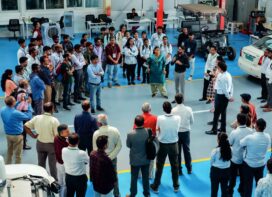
In the pursuit of road safety, technological innovations and infrastructure improvements play pivotal roles in mitigating risks and enhancing the driving experience. Among these advancements, audio tactile markings have emerged as a significant contributor to road safety, particularly on high-speed roads. These markings are not just a measure for traffic management but a critical intervention to reduce the risk of high-speed accidents, especially those caused by driver drowsiness or sleepiness during the wee hours of the day. This technical article by Nitin Nakhat, MD, Pragathi Pavetech Pvt Ltd delves into the concept of audio tactile markings, their benefits, implementations in India, and their global application to enhance road safety.
Audio tactile markings, also known as rumble strips or raised rib road markings, are designed to alert drivers through audible vibrations and tactile feedback when they inadvertently veer towards the edge of the road or across lanes. These markings are strategically installed on the pavements and medians of high-speed roads, including expressways and highways, to catch the attention of the driver through an audible rumbling sound and a distinct vibratory sensation.
The efficacy of audio tactile markings lies in their immediate impact on the driver’s sensory responses. When a vehicle comes into contact with these markings, the vibrations and noise generated serve as an instant wake-up call for the driver, significantly reducing the risk of accidents caused by drowsiness or distraction. The raised rib design of these markings is particularly beneficial, as it ensures that the feedback is strong enough to be noticed, yet not so severe as to cause loss of control of the vehicle.

The Dual Benefit of Raised Rib Markings
Central to the discussion on audio tactile markings is the benefit offered by raised rib markings. These markings serve a dual purpose: firstly, they significantly reduce the likelihood of high-speed accidents by alerting drowsy or inattentive drivers through audible and vibratory signals. Secondly, raised ribs enhance retro reflectivity, especially under wet conditions, ensuring that road markings remain visible even during heavy rain, thus aiding in safer navigation through adverse weather conditions.
Audio tactile markings represent a crucial step forward in road safety technology. Their ability to provide immediate, sensory feedback to drivers has proven effective in reducing accidents caused by drowsiness or inattention, particularly on high-speed roads.
Impact on Reducing Mortality Rates
The effectiveness of audio tactile and raised rib road markings in mitigating high-speed accidents, particularly those caused by drowsiness or sleepiness, cannot be overstated. By providing immediate feedback to drivers veering off their lanes, these markings play a pivotal role in awakening and refocusing the driver’s attention, significantly reducing the incidence of potentially fatal accidents. This aspect of road safety is crucial during the early hours of the day when the risk of drowsiness-induced accidents is at its peak.
India’s Stride in Road Safety Innovations
India’s commitment to enhancing road safety through technological innovations is evident in the successful implementation of audio tactile markings on several expressways. The Bundelkhand Raised rib road markings have shown remarkable effectiveness in tackling and reducing mortality in high-speed accidents, particularly those resulting from driver fatigue. These benefits include: Instantaneous alert providing an immediate alert to drivers; reduced fatalities; enhanced driver awareness especially during the night or in adverse weather conditions; and low-cost of the solution. Compared to other road safety measures, audio tactile markings are cost-effective to install and maintain, offering a high return on investment in terms of lives saved and accidents prevented.

Implementation in India
India, with its vast network of high-speed roads, has recognized the importance of audio tactile markings in enhancing road safety. Projects like the Bundelkhand Expressway and the Gorakhpur Expressway have successfully installed these markings, showing promising results in the reduction of accidents and fatalities. The positive outcomes from these projects have paved the way for the proposed installation of audio tactile markings on future projects, including the Ganga Expressway, Raipur-Vishakhapatnam Expressway, and Bengaluru-Chennai Expressway.
Global Adoptions
The adoption of audio tactile markings extends beyond the borders of India, with several countries recognizing their potential in road safety enhancement. Australia and New Zealand have been pioneers, incorporating these markings extensively across their highway networks. Similarly, in the United Kingdom and parts of Europe, the implementation of audio tactile markings has led to significant improvements in road safety, demonstrating their effectiveness in diverse climatic and traffic conditions. United States has implemented rumble strips on interstates and rural roads. The Gulf and MENA region is now adopting this tech for high speed intercity road and highways in Oman, Qatar and Bahrain. Consideration in UAE, Saudi is going on. In several of these projects, SBRMM is the technology partner.
Challenges and Considerations
While the benefits of audio tactile markings are substantial, their implementation comes with challenges. These include ensuring the markings are discernible under all weather conditions, may interfere with bicyclists and motorcyclists. Addressing these challenges requires continuous research and adaptation of the markings to suit different environments and road types.
As we look towards future projects and innovations, the continued refinement and adoption of audio tactile markings will undoubtedly play a significant role in our collective effort to enhance road safety and save lives. The successful implementation of these systems in India, alongside their global adoption, underscores the universal need for innovative solutions to combat road traffic accidents.
 TrafficInfraTech Magazine Linking People Places & Progress
TrafficInfraTech Magazine Linking People Places & Progress


